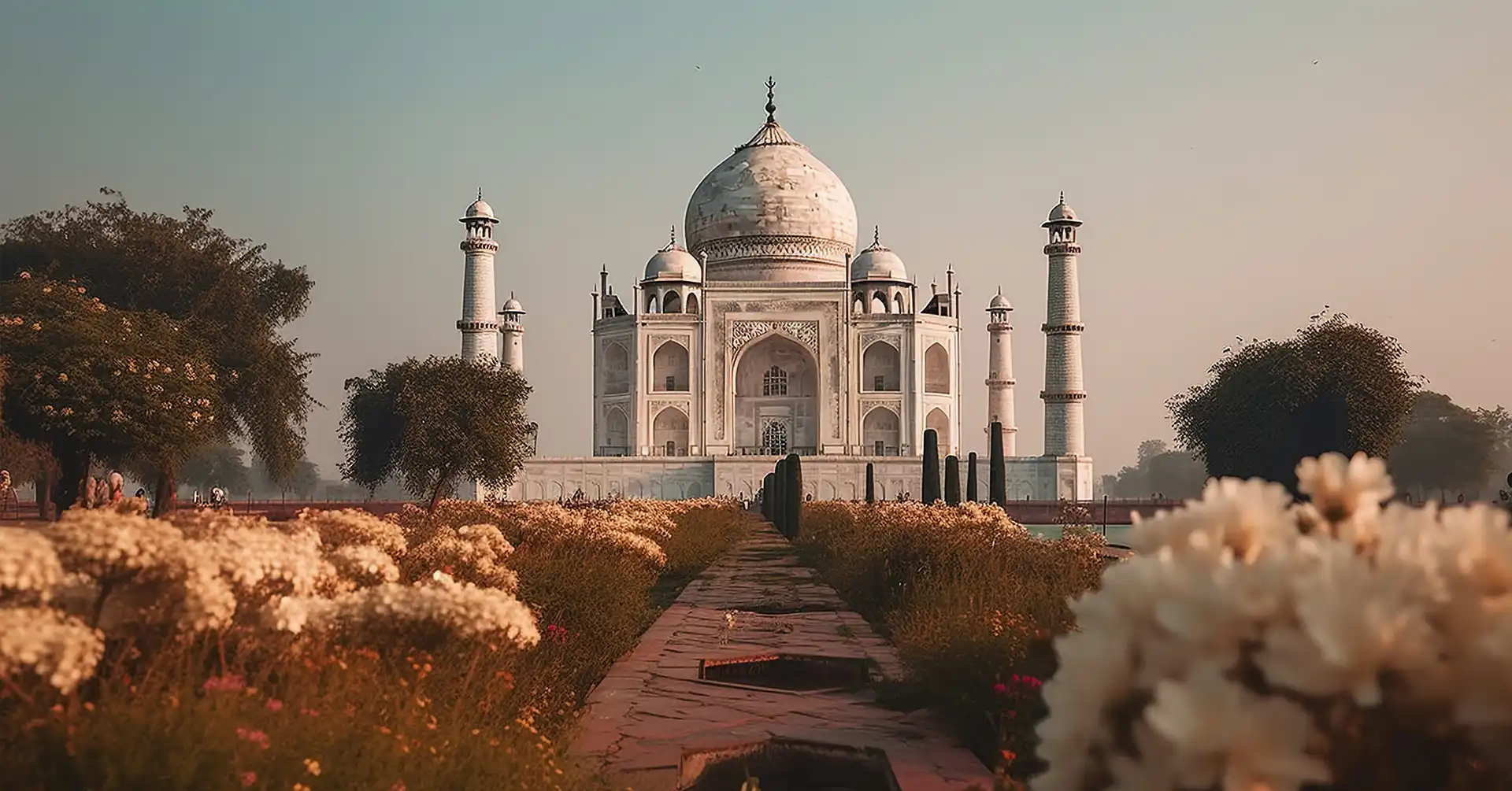Embark on a fascinating adventure through time as we discover the attraction of India’s ancient treasures. From the enduring Taj Mahal to the enigmatic Ajanta and Ellora Caves, be a part of our exploring 21 famous websites that stand as a testament to India’s rich heritage. These historical places in India invite you to witness the artistry, architecture, and narratives that have fashioned the nation’s charming tale.
Historical Places Chart: Historical Places of India
Here we will see some famous historical places in india that also has some historical buildings of India:
- Taj Mahal: The Taj Mahal stands as an extraordinary testimony to eternal love and architectural brilliance. Located in Agra, this ivory-white marble mausoleum was constructed by Emperor Shah Jahan in remembrance of his spouse, Mumtaz Mahal. Its symmetrical design, tricky carvings, and tricky gardens make it an enduring symbol of India’s wealthy background.
- Red Fort: Dominating the skyline of Delhi, the Red Fort is an implementing shape that narrates the grandeur of the Mughal technology. Constructed by Emperor Shah Jahan, its purple sandstone walls enclose a surprise of palaces, courtyards, and gardens, showcasing the fusion of Persian, Timurid, and Indian architecture.
- Qutub Minar: The Qutub Minar, a towering masterpiece in Delhi, represents the triumph of Indo-Islamic structure. Standing at seventy-three meters, this UNESCO World Heritage Site boasts intricate carvings and verses from the Quran, reflecting the artistry of the time.
- Ajanta and Ellora Caves: The Ajanta and Ellora Caves in Maharashtra are a window into India’s ancient beyond. Carved into the rock, these caves exhibit remarkable artistry and nonsecular significance, with sculptures and paintings depicting Buddha’s existence and Hindu epics.
- Fatehpur Sikri: This historic metropolis near Agra became a Mughal capital. The pink sandstone structures, together with the Buland Darwaza and Jama Masjid, illustrate Akbar’s architectural vision and the rich cultural alternative of the technology.
- Hampi: The ruins of Hampi transport visitors to a bygone generation of a terrific medieval metropolis. Situated in Karnataka, these ruins show off difficult temples, palaces, and other architectural marvels, reflecting the opulence of the Vijayanagara Empire.
- Khajuraho Temples: Nestled in Madhya Pradesh, the Khajuraho Temples are renowned for their elaborate sculptures and difficult carvings. These temples celebrate life, love, and spirituality through their art, showing a quality stability of creativity and devotion.
- Konark Sun Temple: A UNESCO World Heritage Site in Odisha, the Konark Sun Temple is an architectural gem dedicated to the Sun God. Designed inside the shape of a chariot with unique carvings, it’s a first-rate example of historic engineering and artistry.
- Agra Fort: This UNESCO-listed fort in Agra is an image of energy and beauty. It encapsulates numerous architectural styles, from the Mughal era to the British colonial duration, and has witnessed numerous ancient activities.
- Mysore Palace: Situated in Karnataka, the Mysore Palace is a great combination of Indo-Saracenic and Dravidian architecture. The palace’s ornate interiors, colorful frescoes, and elaborate detailing talk of the opulence of the Wadiyar dynasty.
- Hawa Mahal: Jaipur’s “Palace of Winds” is a unique five-tale structure with honeycomb-like windows designed to permit royal ladies to examine avenue festivities even while maintaining privacy. Its crimson sandstone façade is an iconic illustration of Jaipur’s architectural background.
- Amer Fort: Perched on a hilltop near Jaipur, the Amer Fort is a majestic fortification that blends Rajput and Mughal architectural styles. The elaborate reflection paintings, creative frescoes, and panoramic views make it a necessity to go to ancient web pages.
- Sanchi Stupa: Located in Madhya Pradesh, the Sanchi Stupa is a sacred Buddhist monument that dates back to the third century BCE. It holds relics of Buddha and is decorated with tricky carvings depicting his existence and teachings.
- Golconda Fort: This imposing castle in Hyderabad reflects the grandeur of the Qutb Shahi dynasty. Known for its acoustics, palaces, and inventive water-delivery machine, it’s a top-notch instance of medieval engineering.
- Humayun’s Tomb: Built in Delhi, Humayun’s Tomb is a precursor to the architectural brilliance of the Mughal dynasty. Its symmetrical layout, Persian-style gardens, and pink sandstone façade are harking back to the Taj Mahal.
- Chittorgarh Fort: Rising dramatically in Rajasthan, the Chittorgarh Fort narrates testimonies of braveness and sacrifice. Its towering gates, palaces, and towers mirror the Rajputana spirit and the fort’s historical importance.
- Victoria Memorial: This majestic white marble monument in Kolkata is a blend of British and Mughal architecture. Dedicated to Queen Victoria, it stands as a reminder of India’s colonial beyond.
- Sanchi Stupa: One of the oldest stone systems in India, the Sanchi Stupa in Madhya Pradesh is a symbol of Buddhism’s influence. Its complicated carvings and serene ambiance make it a pilgrimage website online for Buddhists.
- Gwalior Fort: Overlooking the town of Gwalior, this castle boasts a wealth of records spanning centuries. With its implementing structure, tricky palaces, and the long-lasting Teli Ka Mandir, it’s far a testimony to India’s architectural prowess.
- Mahabalipuram Monuments: The coastal city of Mahabalipuram in Tamil Nadu is adorned with ancient rock-cut temples and complicated sculptures. These UNESCO-indexed monuments tell memories from Hindu mythology and provide a glimpse into historical creative traditions.
- Rani Ki Vav: Situated in Gujarat, Rani Ki Vav is a stepwell that showcases wonderful craftsmanship. Adorned with problematic carvings depicting deities, mythological scenes, and more, it reflects the importance of water and spirituality in Indian culture.
Conclusion
In a land in which history is etched into each stone, India’s ancient places stand as profound testimonials to a legacy that spans centuries. From the long-lasting Taj Mahal to the historic caves of Ajanta and Ellora, these sites weave a story of India’s wealthy cultural tapestry. The architectural marvels like the Red Fort and Qutub Minar, in conjunction with the nonsecular sanctuaries of Sanchi Stupa, provide a glimpse into the diverse aspects of India’s beyond. As you traverse through the historical places in India, you embark on a fascinating adventure that transcends time, connecting the present to the testimonies of the past.
FAQs About Historical Places in India
1. What are historical places in India?
Historical places in India are websites that maintain considerable cultural, architectural, and ancient costs. These locations regularly feature historical monuments, temples, forts, palaces, and different structures which have played pivotal roles in shaping India’s past.
2. How many ancient places are there in India?
India boasts a huge quantity of ancient locations spanning its various regions. While it’s challenging to offer an exact count, there are thousands of ancient websites, each with its personal precise history and importance.
3. Which is the most well-known ancient location in India?
The Taj Mahal in Agra is arguably the most famous ancient place in India. Its lovely architecture and emotional significance make it an iconic image now not just for India but for the sector.
4. Can I visit those historic places?
Yes, many of those historical places in India are open to visitors. Some would possibly have access costs, and it is beneficial to test the journeying hours and any precise guidelines before planning your go-to.
5. What can I examine from those historic locations?
Exploring historical places in India offers insights into the use of a wealthy history, architectural evolution, cultural background, and the tales of the folks who lived in these places. It’s an opportunity to hook up with the beyond and take advantage of deeper know-how of India’s numerous backgrounds..
Also Read:
East Asia Cultural Traditions, Foods, and Etiquette
Dominate the Music Industry with Effective Marketing Strategies






